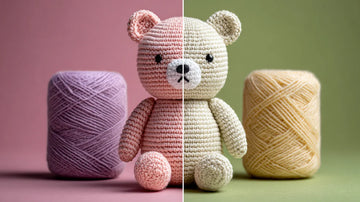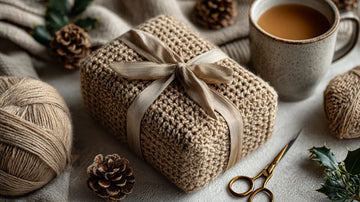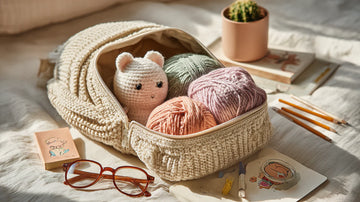Focus keyphrase: best yarn for amigurumi
So you’ve decided to make your first amigurumi plush. It’s an exciting journey into the world of three-dimensional crochet! But before you grab your hook, you'll face a crucial decision: which yarn to use? 🤔 The choice of yarn can make or break your project, affecting everything from how the stitches look to how the finished plush feels. For beginners, the debate often comes down to two popular choices: cotton and acrylic. This guide will help you discover the best yarn for amigurumi by breaking down the pros and cons of each. 🧶🐰
The Golden Rule: Why Yarn Choice Matters
Amigurumi is unique because it requires a yarn that creates a dense, tight fabric. Unlike a blanket, where a soft, flowing fabric is desirable, a stuffed toy needs to hold its shape and prevent the stuffing from showing through. The yarn's fiber content, texture, and elasticity all play a role in achieving this. Using the wrong yarn can lead to a floppy plush or, even worse, a project with visible gaps.
The Case for Acrylic Yarn: Beginner-Friendly & Versatile
Acrylic yarn is a synthetic fiber, but don't let that deter you. It's the go-to for many amigurumi artists, especially those just starting out.
Pros 👍
-
Budget-Friendly: Acrylic is significantly cheaper than cotton, making it a low-risk option for beginners who might need to restart a few times. Our Yarniss Beginner Crochet Yarn is a great example of a beginner-friendly acrylic that won't break the bank.
-
Vast Color Palette: Acrylic yarn comes in an almost endless variety of vibrant colors, which is perfect for creating whimsical, imaginative creatures.
-
Easy to Work With: Acrylic has a bit of stretch to it, which makes it forgiving and easy to work with. It glides smoothly on the hook and is less likely to split, a major plus for new crocheters.
-
Durability & Washability: Acrylic is machine washable and very durable, so your finished plush can withstand years of love and play without losing its shape.
Cons 👎
-
Less Stitch Definition: Acrylic can sometimes look a bit "fuzzier" or less defined than cotton, which may not be ideal if you're aiming for a super crisp, neat look.
-
"Squeaky" Feel: Some crafters find that acrylic yarn can feel a bit "squeaky" as it slides against a polished hook.
The Case for Cotton Yarn: Clean Stitches & Natural Feel
Cotton yarn is a natural fiber known for its durability and clean finish. It's the yarn of choice for many seasoned amigurumi artists.
Pros 👍
-
Excellent Stitch Definition: Cotton has a very low stretch, which results in clean, crisp, and well-defined stitches. Your finished amigurumi will have a very polished, professional look.
-
Natural Feel: Cotton has a wonderful, natural feel that many people prefer to synthetic fibers. It has a nice weight and a matte finish.
-
Durability: Cotton plush toys are incredibly sturdy and will hold their shape exceptionally well over time.
Cons 👎
-
Less Forgiving: The lack of stretch can make it less forgiving for beginners, especially when working on a very tight tension. It can also be more prone to splitting, so a smooth hook is essential.
-
Limited Color Range: While cotton has many colors, the palette isn't as vast or as bright as what's available for acrylic.
-
Higher Cost: Cotton yarn is generally more expensive than acrylic, making it a bigger investment for a beginner.
Side-by-Side Comparison: A Detailed Look
Our Verdict: When to Use Each Yarn
So, which one is the best yarn for amigurumi? The answer depends entirely on you!
-
Choose Acrylic if… you are a beginner, working on a budget, or want a huge variety of vibrant colors. Its forgiving nature makes it the perfect learning yarn. A project-based kit like our Yarniss Beginner Crochet Kit Bunny uses a great beginner-friendly yarn to get you started.
-
Choose Cotton if… you prioritize a clean, neat look and a natural feel. Once you're comfortable with the basic stitches, cotton can take your amigurumi skills to the next level.
Pro Tips for Perfect Amigurumi
No matter which yarn you choose, remember these key tips for success.
-
Hook Size is Key: To achieve the tight stitches needed for amigurumi, you will often need to go down a hook size from the yarn’s recommendation. A small hook with an ergonomic handle, like those in our Yarniss Large Ergonomic Crochet Hooks Set, will make this much more comfortable.
-
Consistent Tension: Practice maintaining consistent tension to ensure your stitches are even.
-
Patience: Amigurumi is a journey of small stitches. Take your time, and enjoy the process of watching your creation come to life. To explore more about the world of plush-making, check out our amigurumi blog section.
-
Ready to find your perfect yarn? Explore our full range of crochet kits and start creating your first plush today!





